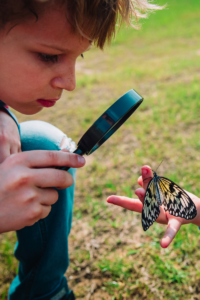Effective Consequences for Kids: Building Lasting Behavior Change through Positive Discipline

Does the word “discipline” conjure up images of time-outs and lectures? For many of us, that’s how we were raised, in authoritarian households where misbehavior often meant a trip to our room or worse. We were expected to do what we were told without hesitation or question.
Thankfully, our own households don’t have to mirror those childhoods. We can break the cycle. Positive discipline offers a more effective approach, fostering growth and development in our children while strengthening our parent-child bond. Within the context of positive parenting, discipline has a whole new meaning.
Discipline vs. Punishment: Reframing the Conversation
The word “discipline” often gets a bad rap. But the true meaning of discipline is far more positive. It comes from the root word “disciple,” which means to teach or guide.

Here’s the key difference: positive discipline focuses on teaching and guiding your child’s behavior, while punishment simply aims to control it.
Why is this distinction important? Studies show that children raised in authoritarian environments (where control is the primary focus) are more likely to engage in risky behaviors. When discipline feels like punishment, it doesn’t lead to lasting learning or growth. The child might simply learn to avoid getting caught, rather than understanding the impact of their actions.
Positive discipline, on the other hand, empowers children. It creates a space for them to learn from their mistakes and develop a sense of responsibility. Through clear expectations, effective consequences, and open communication, you can guide your child towards positive behavior choices.
Guiding Behavior with Positive Discipline
A common misconception about positive parenting is that it means letting kids run wild. Not quite! Positive discipline involves setting clear consequences for unacceptable behavior, but these consequences are designed to be teaching moments rather than punishments.

Think of it this way: Positive discipline sets the bar higher than traditional discipline. We expect children to make positive choices on their own, not just follow orders or avoid punishment. We believe that fostering accountability, responsibility, and self-regulation is far more effective than simply resorting to punishment.
Positive discipline is rooted in the idea that children are capable of learning from their mistakes. By implementing clear consequences, we create opportunities for reflection and growth. Additionally, positive discipline fosters a nurturing environment where children understand the impact of their actions without feeling like we’re the “bad guy.”
Setting the Stage for Effective Consequences
Before diving in further, let’s explore some key considerations that will pave the way for implementing consequences that are both effective and nurturing. By keeping these factors in mind, you can transform consequences from punishment into powerful teaching moments that foster growth and positive behavior change.

1. Understanding Developmental Challenges:
It’s important to remember that young children are still learning and developing crucial skills. Their ability to focus for extended periods or control their impulses is a work in progress. Recognizing these developmental challenges can help us approach discipline with empathy and understanding. For example, a toddler may not be able to focus on a task for more than 10 minutes, so expecting them to sit quietly for an hour is unrealistic. By setting age-appropriate expectations, we can avoid frustration and set our children up for success.
2. Age-Appropriate Boundaries:
When setting boundaries for your child, consider their age and stage of development. Toddlers and preschoolers thrive with consistent routines and clear expectations. Establishing simple, age-appropriate rules can provide a sense of structure and security, guiding their behavior in a positive direction. Remember, consistency is key! Enforcing boundaries consistently helps children feel secure and understand what’s expected of them.
3. Communicating Boundaries:
Ensure that your child understands the boundaries by explaining them in a clear, simple, and age-appropriate manner. Use positive language and focus on what they can do rather than what they cannot do. For example, instead of saying, “Don’t touch that,” you could say, “Let’s keep our hands on our toys.”
4. Natural Consequences:
One effective approach to consequences is allowing natural consequences to occur when appropriate. Natural consequences are the direct result of a child’s behavior and can be valuable teaching moments. For instance, if a child refuses to eat their dinner, the natural consequence is feeling hungry later. Experiencing the consequence can help them understand the connection between their actions and the outcomes. Keep in mind: Natural consequences are not appropriate for situations that could be dangerous.
5. Logical Consequences:
In situations where natural consequences may not be immediate or safe, logical consequences can be implemented. Logical consequences are directly related to the behavior and aim to teach responsibility. For example, if a child refuses to clean up their toys, a logical consequence might be temporarily putting the toys away until they are ready to clean up.
Remember, the goal is not to punish your child but to provide opportunities for learning and growth. Consequences should be communicated calmly and respectfully, focusing on the behavior rather than the child. By doing so, you can empower your child to understand the impact of their actions and make better choices in the future.
Putting Consequences into Action

There’s a simple, yet powerful, way to implement consequences that feels almost magical. It’s all about empowering your child through choice, and my favorite tool for doing this is the phrase:
“If you choose [action/behavior], then you choose [consequence].”
This may sound simple, but the benefits are real. Here’s why:
- Clear Cause-and-Effect: By directly connecting choices to consequences, children learn the natural results of their actions. This helps them visualize the “good” and “bad” outcomes of different choices.
- Taking Ownership: Understanding this connection empowers them to take ownership of their behavior and the resulting consequences. They learn that they have control over their choices.
- Shifting Perspective: The phrase frames consequences as the natural outcome of a choice, not a punishment imposed by you. This creates a more positive and cooperative dynamic.
Examples:
- “If you choose to draw on the wall, then you choose to lose your drawing privileges for the rest of the day.”
- “If you choose to run away from me, then you choose to ride in the stroller.”
- “If you choose to turn off the TV after this show, then you choose to watch TV again tomorrow.”
But wait! Before you go forth and start implementing this phrase into your daily life, stick with me a little longer. Because simply imposing a consequence isn’t always enough. To ensure consequences are truly effective, especially for young children, it’s important to follow a few key rules.
Making Consequences Count: 5 Key Rules

Here are four key rules to ensure your consequences are effective, respectful and guide your child towards positive behavior change:
1. communicate consequences in advance
Children thrive on routine and knowing what to expect. Instead of getting caught up in the moment and reacting harshly, give your child a chance to consider (or reconsider) their choices. Talk about the potential consequences before implementing the consequences. This allows them to make informed decisions and avoid surprises.
- Instead of: “You chose to throw your toys, so I’m taking away your toys.”
- Try: “If you choose to throw your toys one more time, then you’re choosing to put them away for the day.
2. Consequences Should Be Connected to the Behavior
For kids to link their actions and the outcomes, there should be a clear connection between a child’s actions and the outcome. This helps them understand how their choices impact the world around them. Avoid unrelated consequences that feel like punishments.
- Instead of: “If you choose to pull your sister’s hair, then you choose to not watch TV tonight.”
- There is no connection between hair-pulling and TV time, so it doesn’t teach a lesson. It’s a punishment.
- Try: “If you choose to pull your sister’s hair, then you choose for playtime to be over. Hair-pulling hurts, and we only play with gentle hands.”
- This consequence directly relates to the action (pulling hair) and helps them understand the consequence of their choice (no more playtime).
3. Consequences Must be Appropriate and Fair
Choose consequences that fit the severity of the behavior and your child’s age. When the ‘punishment doesn’t fit the crime’ or the consequence doesn’t make sense, your child may focus on the punishment itself, rather than understanding the reason behind it.
- Instead of: “If you choose not to wear your helmet, then you choose to throw your bike in the garbage!”
- This feels unfair and doesn’t encourage responsible behavior. Your child will focus on the ‘unfairness’ of the consequence instead of the importance of wearing a helmet.
- Try: “If you choose not to wear your helmet, then you choose not to ride your bike today. It’s important to wear a helmet to keep you safe.”
- This consequence is reasonable, an appropriate consequence for the behavior, and allows even young children to understand the importance of safety choices.

4. Consequences Should Guide, Not Punish
The ultimate goal of consequences is to help your child learn, grow, and become responsible decision-makers. Consequences are a teaching tool, not a punishment. Focus on helping your child learn from their choices and find solutions for better behavior in the future.
5. Be Consistent!
Children thrive on routines and predictable outcomes. This applies to consequences as well! When you establish a consequence for a behavior, consistently following through is crucial. Think of it like learning a new skill – repetition reinforces the connection between actions and consequences.
Here’s why consistency matters:
- Clear Expectations Prevent Confusion and Power Struggles: Inconsistent consequences create confusion. Let’s say your child sometimes gets to watch one TV show before bed, and other times they get to watch three shows. Every night after the first show they might try to push boundaries for more because they know it’s a possibility. This can lead to power struggles and tantrums and a less-than-smooth bedtime routine. Clear expectations, enforced consistently, help children understand what’s expected of them.
- Explaining “Gray Areas” Helps Children Navigate Different Situations: There will be times when a behavior might seem okay in one situation but not another. Explain these “gray areas” clearly. For example, playing with water toys outside might be fine, but splashing indoors is not. By explaining these differences in advance, you help your child navigate these situations.
- Following Through Builds Trust and Enforces Boundaries: Following through on consequences builds trust. Empty threats erode trust and make consequences meaningless. Children learn that your words carry weight and that there are clear expectations in place. Consistency doesn’t mean rigidity, but overall, it establishes clear boundaries and helps your child learn from their choices through predictable consequences.
By following these simple rules, you can effectively use consequences to guide your child’s behavior in a positive and supportive way.
More Examples:

“If you choose to hit your brother, then you choose to take a break and calm down before playing again.”
“If you choose to not stay near me when we are walking, then you choose for me to carry you.”
“If you choose not to follow the rules of the game, then you choose to stop playing the game.”
“If you choose to cut in line, then you choose to get out of the line and lose your turn.”
Building a Foundation for a Lifetime
Positive discipline isn’t just about managing behavior in the moment; it’s about building the foundation for your child’s future. By embracing positive discipline, you’re not just shaping their actions, you’re shaping their character. You’re nurturing a child who is responsible, compassionate, and equipped to navigate life’s challenges with confidence and grace.
Imagine a future where your child takes ownership of their mistakes, solves problems independently, and expresses their emotions constructively. Positive discipline empowers them to become this kind of person.
This journey may not always be smooth sailing, but by prioritizing connection, communication, and consistent guidance, you’ll cultivate a strong parent-child bond built on mutual respect and understanding. Remember, positive discipline is a continuous learning process, for both you and your child. Celebrate the small victories, embrace the growth, and enjoy the beautiful chaos of parenting together. As you embark on this transformative journey, you’re not just raising a child, you’re shaping a future filled with possibility.
So tell me, does this post help you feel differently about discipline with positive parenting?





